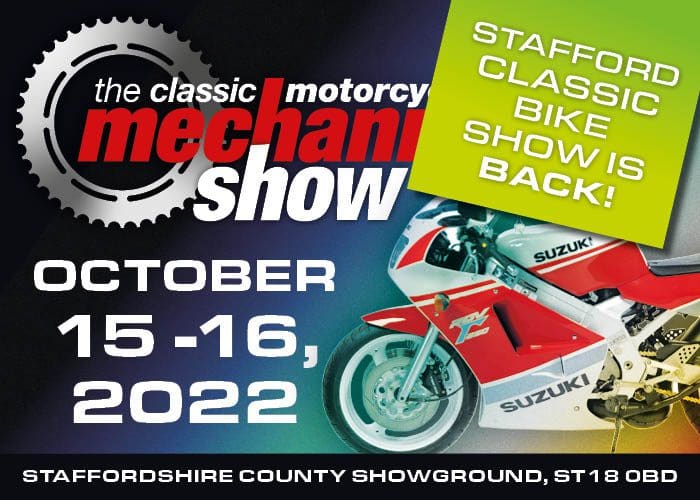Big parallel twins are back in fashion, apparently, but Scoop rides an original example, Yamaha’s XS650C.
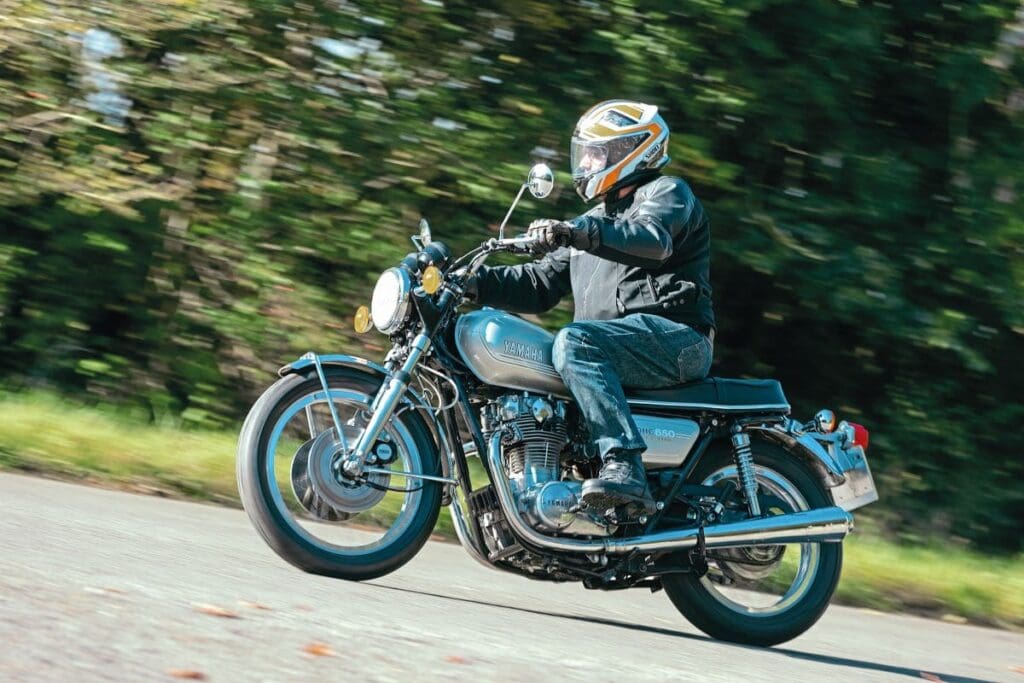
Words: Steve Cooper Pics: Gary Chapman, Mortons Archive
If you were to listen to the modern bike press you might very well conclude the latest tranche of larger parallel twins is akin to the second coming – well, third if we’re being accurate here.
The likes of Honda’s new Hornet, Suzuki’s multi-platform 800, Aprilia’s RS660 and more are the new ‘must haves’. Truth be told, a certain firm based in Iwata, Japan, started the current trend back in 2014 with the sublime MT-07, but that’s only part of the story.
Yamaha has a thing about parallel twins – some have been stunning, other’s dire, but they always seem to come back to them. The company revisited the concept in earnest back in 1991 with the immensely competent TDM850. Some called it the ‘TEDIUM’ whilst others referred to it as ‘the only motorcycle you’ll ever need!’. Sadly. the British public wasn’t quite so sure even if the bikes in both 850 and 900 guise sold well enough globally and were the second best sellers in capacity class (to the VFR series) in Europe. Today it’s likened to a Ducati Multistrada before Bologna’s boffins dreamed up the idea.
So these modern big bore parallel twins (and the 90s precursors) are readily accessible, fun to ride, reliable and fast enough for most riders, right? The buzzwords are, variously, manageable, user-friendly, straightforward, comprehensive, etc. All great stuff, but what if you want all of these attributes in a classic? If we were a sales person in a classic bike emporium CMM would now be gently leading you to gaze lovingly at what many still consider to be the best all-round Japanese classic there is. In gilded, honeyed tones we’d be purring: “perhaps madam/sir might like to consider the incomparable Yamaha XS650 twin?”
Okay, so enough schmoozing already. Most of us know about what many consider to be a Brit-Bike rip-off, but here’s the deal. When the late Tony Hall was running Halco (THE XS650 go-to in the UK) and importing container loads of XS650s from the USA, generally he reckoned the bikes sold themselves based upon their very solid reputation. However, if a customer was dithering about whether to commit, Tony had a killer line: “They’re just like an old Triumph twin; the only difference is you don’t have to push them home!” Harsh but probably fair, and that one phrase was often enough to close the deal.
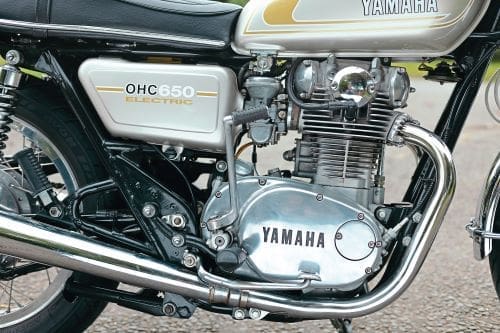


Truth be told the XS650 was never a huge seller in the UK when it was new. Yes, Yamaha shifted significant numbers of them but volumes weren’t ‘substantial’. At a guess it’d be fair to say the firm sold more of the 125/200 twins than it did the 650. Meriden was still in operation and folk who wanted a lusty big four-stroke twin bought a Bonnie or a Tiger. Mitsui, the then importer, often skipped year-on-year models simply because shifting what it had was hard enough; all of which means that this month’s Swiss market XS650C is a rather rare beast here in Blighty. To all intents and purposes our bike in camera is a silver version of the UK’s black XS650B but apparently there are some differences, notably inside the Mikuni BS38 CV carbs that were jetted to comply with Switzerland’s tighter emissions regulations of the period.
The XS650 changed very little other than colours, decals and badges from 1974 to 1978/9 when the factory custom Specials made their appearance. Examples like our one here latterly have become known as ‘roadster’ simply to distinguish them from from their more laid-back, cruiser cousins.
One of quirks of the XS650 roadster build is the number of disc brakes fitted at the sharp end. European market models had a pair of stainless rotors, but American market examples ran just one larger disc – the master cylinders were altered to suit. General equipment fitment was fairly standard fare across much of the Yamaha range from above 200ccs and the contemporary RD250/350 models ran pretty much identical switchgear (electric starter excepted), gauges and their binnacles. Only the gearing inside the instruments and the numbers on the dials changed. If you’re a fan of the big twin you may have spotted the rear light’s profile which is at odds with the UK models. We received the classic teardrop lens as fitted to the Fizzy and everything else whilst most other countries had a round ‘elephant’s foot’ lens. Our test bike, owned by Jeff Peyton-Bull, features the much earlier lens as fitted to the 1970 XS-1 and other early American market Yamahas. So has someone retro-fitted the wrong one? No, apparently not as most German market Yamahas of the period also featured the same unit.

Yamaha was pragmatic enough to appreciate that the XS650 was always going to be likened to the various big British twins and that it needed to refine the concept rather than try to reinvent it. The end result was a solid and reliable 650 parallel-twin with the rough edges knocked off, together with a decent degree of refinement. Yes, a 360-degree twin will always pulsate and shudder but that doesn’t mean those vibrations have to unduly affect the rider. The foot-rests mount to the swingarm gussets via substantial rubber bushes that stop most of the oscillations getting to your feet, and the handlebar mounts in the top yoke similarly protect your hands. The tail-light assembly and rear indicators get rubber-assist; ditto the front light via damping rings under the headlight mounts. Unlike our home-spun iterations, XS650s tend to be rider and bulb friendly.
The post-1973 models are sometimes criticised for being a tad lardy but that mass also helps to soak up and damp down vibration. Carrying a bit of extra weight can sometimes be a good thing! More sophistication is evident from the bike’s wheels. There’s no real need to fit flanged alloy rims to a chunky monkey like this but the flanged Takasagos add a little extra class to the deal. Back when the bike was new such details were serious news and conferred additional bragging rights. Elsewhere there’s a push-to-cancel indicator switch which brought the bike bang up-to-date with everything else out there. But enough anoraking, it’s time to ride this extremely well-turned-out example.
Owner Jeff has ridden the bike to our photoshoot location so there’s no need to use the choke, but it’s readily accessible off the back of the left Mikuni. Unlike many bikes of the period, the XS has twin fuel taps and it pays to ensure they are both in the ON position before starting a long ride. Yamaha retrofitted an electric start from the 1972 XS-2 model and it is, quite frankly, a bit of a lash up and something well acknowledged within XS650 circles. Springs, gears, a Bendix mechanism and various other paraphernalia engage with the bike’s internals to deliver an electric foot. This little lot can make the most unholy of noises but fortunately our test bike starts on the button without undue clatter. Instantly there’s the distinct exhaust note of a 360 twin from those long, tapered silencers and blip of the throttle confirms all is well. The bike snicks into gear without issue and it’s time to sample the delicious grunt available. The overhead cam top-end means the bike is as happy buzzing as much as it is plodding. There’s go aplenty when you need it and no need to be afraid of spinning up the revs. In fact, keeping the motor moving rather than slogging it in a high gear at low rpm is the best way to enjoy the big XS – it makes maximum torque just 400rpm below maximum power. This is one very appreciable factor that distinguishes the Yamaha from the British iron that inspired it. It’s not a rocket-ship and was never designed to be so, but it’ll keep on packing away the miles as long as it has fuel.


Being wide and roomy, that seat is more than up to the job of touring, and those subtly tall handlebars are matched well enough to the bike’s purpose and capabilities. Former Triumph racer and senior test rider Percy Tait had been employed by Yamaha Holland to overhaul the road manners of earlier models. This shines through because the bike’s handling is rather good within the context of the period and you would have to do something remarkably stupid to get it to behave badly. It feels planted and stable under all conditions and never gives you a moment’s concern it might randomly wander ‘off-piste’ ever. The rear drum brake is better than many and, being rod operated, has loads of feel. Up front that pair of cast iron, twin piston, calipers are more than up to the task. Said to have been made under licence to Girling or Lockheed, they eclipsed pretty much everything else back in the day and are still good now. Our test bike runs SBS brake pads and they are definitely better than many of the pads available for these calipers. Sadly, Yamaha went to single piston, alloy calipers for the later 1977 D model and they were never as efficient as these units here.


Perhaps surprisingly, these post-1972 XS650s don’t immediately come across as anything particularly outstanding, which means they get regularly overlooked. Even as the heat goes out of some of the classic scene’s ferocious prices anything supposedly iconic is still serious money. Really good, authentic, XS650 roadsters are still under five grand which is exceptional for such an eminently usable classic. The ‘value’ of the big twin is in its dogged reliability, its hugely engaging motor, its dependable running gear and its classical, tempered, styling.
It’s anything but bland and when folk say these bikes have character they’re not making veiled excuses for engineering foibles and manufacturer’s oversights – unlike some other big parallel twins. As comfortable as your favourite shoes, as faithful as your dog and as dependable as your best mate, there really is little not to like.
It’s a given that modern parallel twins are substantially lighter and significantly faster, and unquestionably more sophisticated than Yamaha’s XS650. On paper they totally eclipse the classic tested here but – get this – they don’t have the soul of the big Yamaha and for me that’s priceless and a good enough reason to want one.
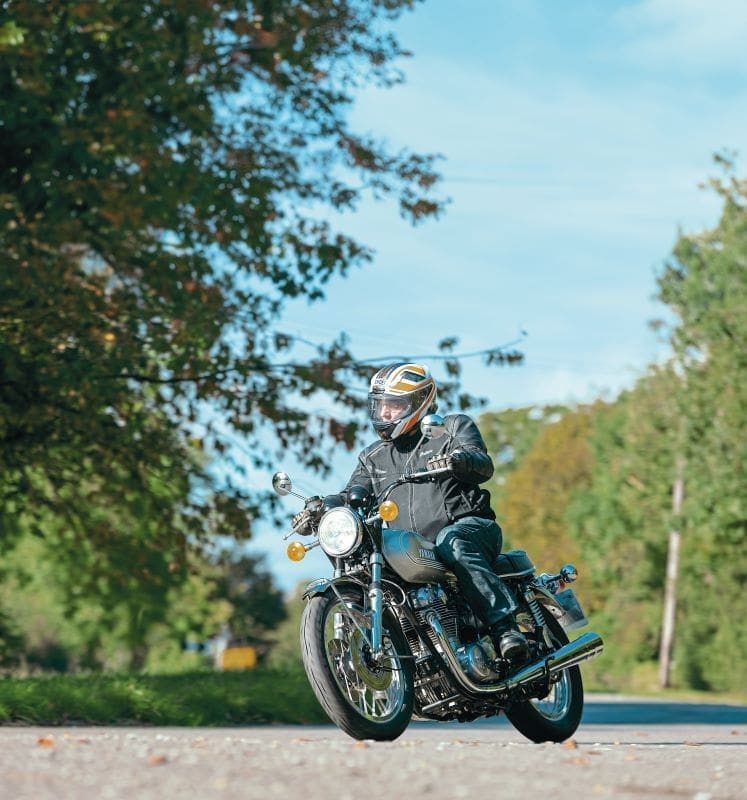
Mixing it up a bit
Vincent designer and engine guru Phil Irving theorised about the early Honda twins and how to reduce their motors’ inherent vibration.
Smoother than the traditional 360-degree motor, Honda’s various C/CB twins, with their 180 cranks, tended to ‘buzz’. The great man concluded that a 76-degree staggering (or 284 depending how you look at it) of the crank pins would reduce vibes massively.
Sadly, the idea got nowhere within the established industry but many fans of the parallel twins took heed and began experimentation. Then some Australian fans of the XS650 took up the challenge. The bike’s crank is a pressed-up affair based around the two-stroke expertise at the time of the design process and features a 13-spline centre join. Simply by splitting the crank at the centre and ‘rephasing’ the crank pins relative to each other, it was immediately possible to create a 277/83 degree bottom-end. After cutting the camshaft and rejoining it at the appropriate angle the rebuilt motor ran and sounded like a V twin… with noticeably less vibration.

Subsequent engineering work now has XS cranks set at the ideal 270/90 stagger, and either set up fully validates Irving’s calculations. Yamaha went precisely this very way with the TDM/TRX850 and then latterly ‘rediscovered’ the concept with race bikes and R1s in the guise of the cross-plane crank. Pretty much everyone and their uncle now offers a 270-degree big twin and the bike-buying public can’t get enough of them apparently. What goes around comes around, eh?
The owner’s view by Jeff Peyton-Bull
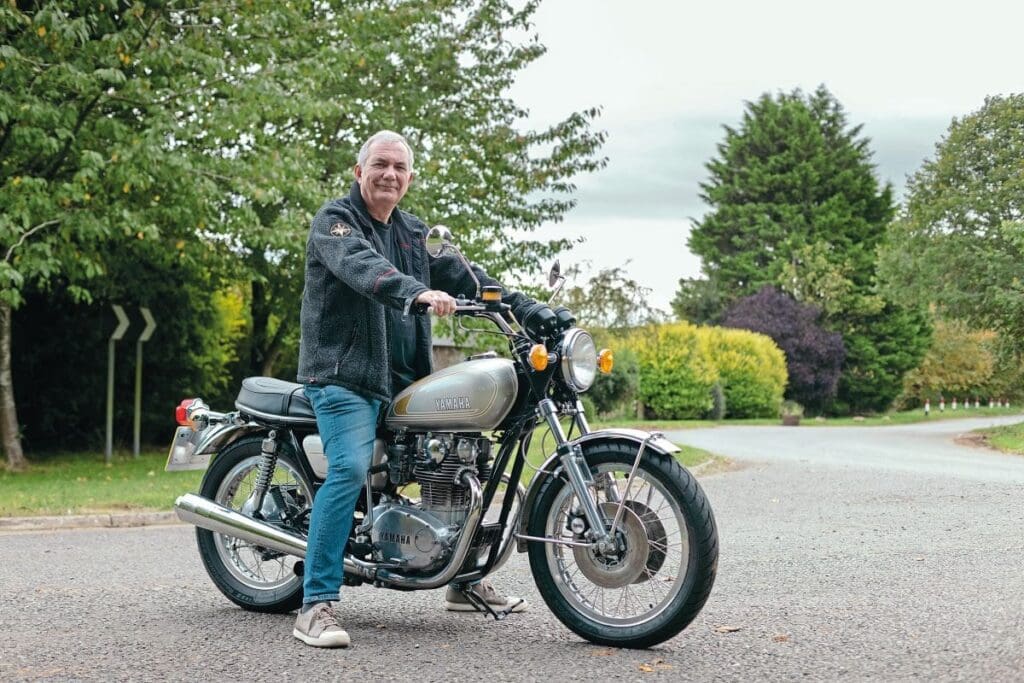
“You know how it is? You’ve been lucky enough to pay off the mortgage, the kids have left home, you are semi-retired and bored, and you’ve managed to accrue enough savings/pension pot/part-time job to indulge yourself. Thoughts turn to your ‘yoof’, and in the case of us bike-types, invariably that includes fond (and not so fond) memories of bikes we had. In my case, the first was a 1973 Casal K190 sports moped made in Portugal, larger than a Fizzy (I was a big lad even then) and rarer now than the proverbial. Next came a Kawasaki G7T 100cc (later became the KH100), and this was okay but not memorable. A brief spell in a Reliant Regal van to keep mum happy, but horrible, led to a 1972 Yamaha XS2, original UK spec in orange/yellow/black and also now rare and I couldn’t find a nice one.
Then in August 2019 I saw a dealer advert for a mint XS650C, imported on a 1979 T-plate, and bought it. It turned out to have been built in August 1975, but not registered in Switzerland until 1979, which is the date the DVLA took when imported, and even with VJMC proof of the 1975 build, they wouldn’t give it a 1975-related number, so I bought a ‘cherished plate’ to remove the incongruity. The clock read less than 4000km and it was nearly perfect, though the tank and side-panels were faded and the decals cracking, so I agonised over ‘original v restored’ and got it beautifully painted by Dave Burton at JBS Yeovil.
Fitted a new starter, Bendix (a well-known issue); new clutch plates and springs as it was slipping – the springs lose their temper over time, and the previous owner had used semi-synthetic oil, so I used good old 20/50. Refurbed the calipers and fitted new SBS pads to sharpen the brakes: the rear indicators didn’t look right though, and I found they were fitted using 15mm pipe wrapped in black tape. A check in the parts book found that chrome brackets were missing, and got them on eBay from the States. The indicator stems were short like a DT175 stem, so I got longer ones which look great, only to find that the Swiss spec was for short ones! Now I have a beautiful XS650C that actually rides much better than my knackered and ill-handling XS2.”
Specification
Engine type: 653cc air-cooled, four-stroke twin, SOHC, 2 valve head
Bore and Stroke: 75.0 x 74.0mm
Claimed Horsepower: 53bhp @ 7200rpm
Maximum Torque: 39.8lb-ft @ 6800rpm
Transmission type: 5 speed
Compression ratio: 8.4:1
Carburetion: 2 x Mikuni BS38 CV type
Tyres: 3.50 x 19 (F) 4.00 x 18 (R)
Fuel Capacity: 3.3 gallons (15 litres)
Brakes: Disc x 2 (F) Drum (R)
Dry weight:191kg (420lb)




